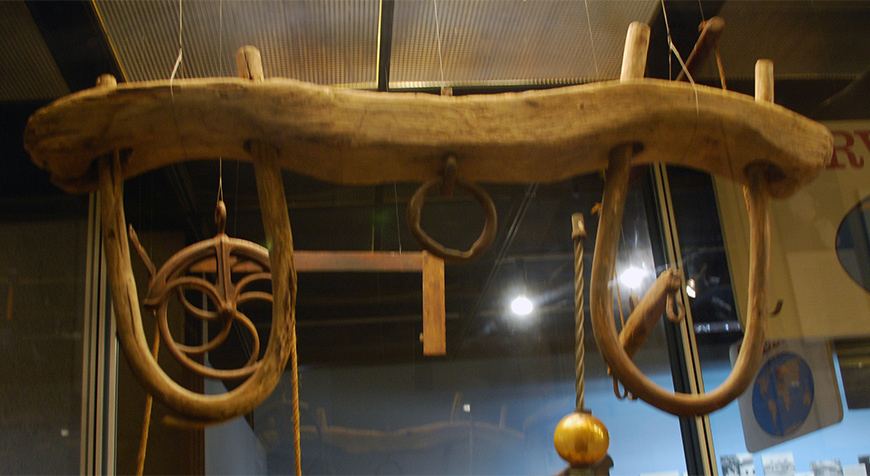This object is an ox yoke made out of wood. A yoke is a wooden beam used to help carry or pull heavy objects by distributing the weight evenly on both shoulders and can be used by humans and animals a like. There are three main types of yokes and it depends on what it is being used by. The first type of yoke is used by humans. A yoke used by humans would be a single beam of wood that sits on their shoulders where the back meets with the neck. The other two are for animals, one for a single animal and the other for two. If a single animal were to use a yoke then it would be made similar to that of the ones used by humans, but a with loop hold it in place around their neck. The two animal yoke, which is referred to as a team yoke, would be a longer beam of wood and have two loops, one for each animal.
Animal yokes allow animals to pull farming equipment, like a plow, along with wagons and carriages. The animals most commonly used to pull farm equipment, wagons, and carriages are horses, donkeys, mules, and oxen. The reasons these types of animals are used are due to their strength. Each of these types of animals all has their own merits and faults. Some of the benefits of theses animals are that they can help with a variety of crops, by lowering costs on gas and repairs for tractors, and by creating manure that works as fertilizer.
Historically, by growing the grains and oats that each animal ate decreased the amount of money spent on buying food and increased the the potential profitability of farming. Additionally, with the animals came a natural source of manure that can be used as fertilizer. With these things in mind a farmer had almost everything needed to run a successful farm with healthy soil, a way to plow and plant, and a way to fertilize the soil in a single purchase of a horse, donkey, mule or oxen. However, as farm tractors and machinery developed the number of farms decreased while the size of the average field grew. It wasn’t long before animal based farming became too slow and time consuming to keep up with the increasing production needs of a modern farm.
Donkeys are members of the horse family that have adapted to desert areas. The donkey’s ancestors are from Africa and the first domestic donkeys can be traced back to around 4000 B.C. and 3000 B.C. in Lower Egypt. Donkeys are considered by many to be a stubborn animal due to their stronger sense of self-preservation. Donkeys unlike the horse, who would be willing to work itself to death, will stop when it feels that it is in danger. Also, unlike the horse and the ox, donkeys tend to be used only for pulling carts, or to carry things on their backs and are prized for their ability to handle steep and rocky terrain. Mules are a produced from the breeding of male donkeys and female horses, but the breeding of a female donkey with a male horse produces a hinny. Mules tend to be larger than donkeys are are better able to pull heavy loads.
Oxen are bulls that have been castrated and are usually easier to handle than intact bulls. Oxen are used in pairs to pull carts and farm equipment. When using animals to pull farm equipment Oxen tend to be the better of the choices. This is due to their ability to pull heavier things and to work longer than the horse or the donkey, but it will take longer for them to work, because they are slower. Oxen can also help with more than just pulling equipment they can also help with threshing by walking over the grain and they can help power machines for grinding grain. However, they don’t make good choices for riding, areas where the horse, mule and donkey excel.
